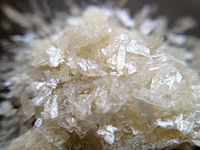Sodium diethyldithiocarbamate
 |
|
 |
|
 |
|
| Names | |
|---|---|
|
IUPAC name
sodium (diethylcarbamothioyl)sulfanide
|
|
| Identifiers | |
|
148-18-5 |
|
| 3D model (Jmol) | Interactive image |
| ChEMBL |
ChEMBL107217 |
| ChemSpider |
8642 |
| ECHA InfoCard | 100.005.192 |
| PubChem | 533728 |
| UNII |
A5304YEB5E |
|
|
|
|
| Properties | |
| C5H10NS2Na | |
| Molar mass | 171.259 g/mol (anhydrous) |
| Appearance | White, slightly brown, or slightly pink crystalline solid |
| Density | 1.1 g/cm3 |
| Melting point | 95 °C (203 °F; 368 K) |
| Soluble | |
| Solubility | soluble in alcohol, acetone insoluble in ether, benzene |
| Hazards | |
| Main hazards | Harmful |
|
Except where otherwise noted, data are given for materials in their standard state (at 25 °C [77 °F], 100 kPa).
|
|
|
|
|
| Infobox references | |
Sodium diethyldithiocarbamate is the organosulfur compound with the formula NaS2CN(C2H5)2.
This salt is obtained by treating carbon disulfide with diethylamine in the presence of sodium hydroxide:
Other dithiocarbamates can be prepared similarly from secondary amines and carbon disulfide. They are used as chelating agents for transition metal ions and as precursors to herbicides and vulcanization reagents.
Oxidation of sodium diethyldithiocarbamate gives the disulfide, also called a thiuram disulfide (Et = ethyl):
This disulfide is marketed as an anti-alcoholism drug under the labels Antabuse and Disulfiram. Chlorination of the above-mentioned thiuram disulfide affords the thiocarbamoyl chloride.
The diethyldithiocarbamate ion chelates to many "softer" metals via the two sulfur atoms. Other more complicated bonding modes are known including binding as unidentate ligand and a bridging ligand using one or both sulfur atoms.
Complexes of Dithiocarbamates with iron provide one of the very few methods to study the formation of nitric oxide (NO) radicals in biological materials. Although the lifetime of NO in tissues is too short to allow detection of this radical itself, NO readily binds to iron-dithiocarbamate complexes. The resulting mono-nitrosyl-iron complex (MNIC) is stable, and may be detected with Electron Paramagnetic Resonance (EPR) spectroscopy.
The effect of diethyldithiocarbamate of chelating zinc inhibits metalloproteinases, which in turn prevents the degradation of extracellular matrix, which is an initial step in cancer metastasis and angiogenesis.
...
Wikipedia
